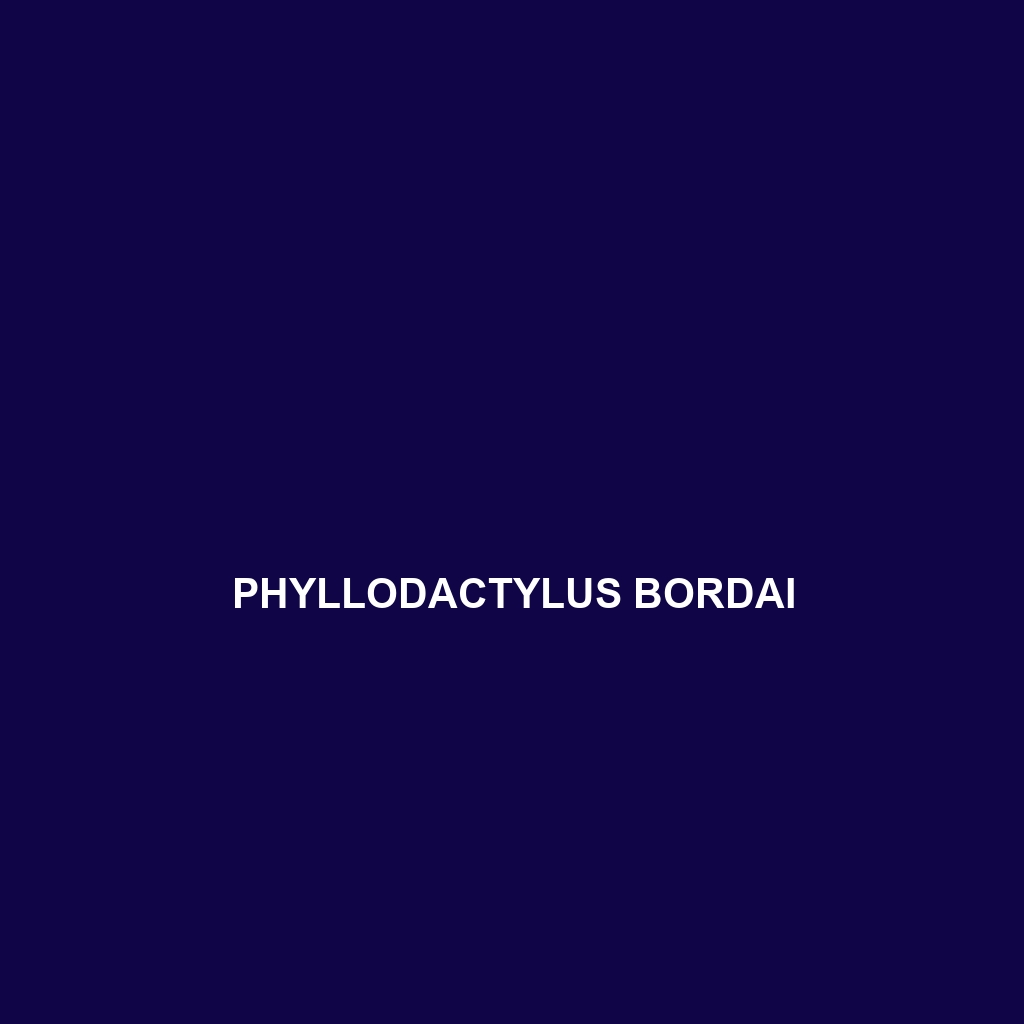Common Name
Phyllodactylus bordai
Scientific Name
Phyllodactylus bordai
Habitat
Phyllodactylus bordai primarily inhabits the dry habitats of arid landscapes, including semi-deserts and scrublands, particularly found in regions across parts of South America. Geographic areas known for hosting this species include the arid regions of Peru and surrounding countries characterized by low vegetation and rocky outcrops. The climate in these regions varies but is generally marked by low rainfall, warm temperatures during the day, and cooler nights, combining to create an ideal living environment for this resilient gecko. This lizard thrives in environments where temperatures can fluctuate significantly, often seeking shelter under rocks or within crevices during peak daylight hours. The adaptability of Phyllodactylus bordai to these semi-arid zones demonstrates its evolutionary journey to coexist with shifting environmental conditions.
Physical Characteristics
Phyllodactylus bordai is a small to medium-sized gecko, typically measuring between 10 to 15 centimeters in length. It has a slender body with a flat head and distinctive broad toes, which allow it to easily navigate the rocky terrains of its habitat. The coloration of this species is one of its most striking features, often exhibiting a mix of browns, tans, and grays, which provides excellent camouflage against the arid ground and rocky surface. Some individuals may have darker blotches or patterns, enhancing their natural ability to blend into the surroundings. Additionally, their skin texture is granular, which helps to reduce the risk of dehydration, a critical adaptation in their dry habitats.
Behavior
This species has a predominantly nocturnal behavior, coming to life after sunset to hunt and forage. During the day, Phyllodactylus bordai remains hidden under rocks and debris to evade predators and conserve moisture. Social interactions among these geckos are generally minimal, but during the mating season, males engage in displays of dominance, which can include head-bobbing and tail waving. Mating rituals typically occur in spring, with males vying for the attention of females through vibrant displays. Their elusive nature makes them fascinating to observe, as they exhibit swift movements when exploring their territory or evading threats.
Diet
Phyllodactylus bordai is an insectivore, primarily feeding on a variety of insects and arthropods that are abundant in their habitat. Their diet consists of crickets, beetles, and small invertebrates, which they skillfully hunt during their nocturnal activities. This gecko’s ability to adapt to seasonal changes in food availability is notable; during times when insects are less plentiful, they may also consume nectar or fruit, showcasing some omnivorous tendencies. Their foraging behavior includes slow and deliberate movements to capture prey effectively, relying on their keen eyesight and rapid reflexes.
Reproduction
The reproductive cycle of Phyllodactylus bordai is fascinating, as the species exhibits oviparous reproduction, laying eggs rather than giving birth to live young. Mating typically occurs in the warmer months, with females laying two eggs at a time in secure locations, such as under rocks or in sandy crevices, where they are less vulnerable to predation. The gestation period for these eggs typically lasts approximately 30 to 60 days, after which hatchlings emerge ready to begin their independent lives. Parental care is minimal; however, the choice of nesting sites is crucial for the survival of the offspring, as they depend on concealed locations to avoid predators.
Conservation Status
Currently, Phyllodactylus bordai has not been classified as endangered or vulnerable and is listed under the category of ‘least concern’ on the IUCN Red List. Nonetheless, habitat destruction due to urbanization and agriculture poses a potential threat to their populations in specific regions. Conservation efforts focus on habitat preservation, which is vital for sustaining their ecosystem. Ongoing studies aim to assess any population trends, and environmental policies are being adapted to safeguard these unique lizards against future threats.
Interesting Facts
A unique aspect of Phyllodactylus bordai is its remarkable ability to change color slightly, depending on the temperature and moisture levels in its environment, which aids in thermoregulation and camouflage. Additionally, these geckos are known for their elaborate shedding process, where they can represent a behavior called autotomy, allowing them to shed part of their tail to escape predators. This fascinating trait highlights their adaptations in survival.
Role in Ecosystem
Phyllodactylus bordai plays a significant ecological role as both predator and prey within its habitat. As a primary insectivore, it helps regulate insect populations, contributing to the control of pest species and maintaining ecological balance. Its existence supports the food chain, providing sustenance for larger predatory species. Furthermore, through its feeding habits, it facilitates nutrient cycling within the ecosystem, enhancing soil health and plant growth. Thus, this gecko’s presence is integral to sustaining the ecological integrity of its environment.
